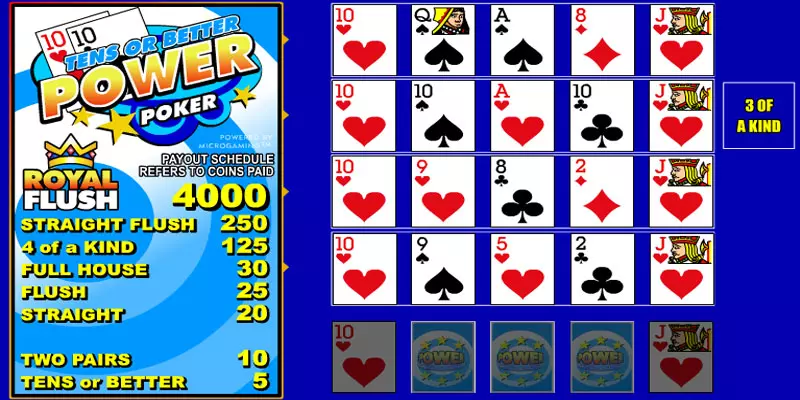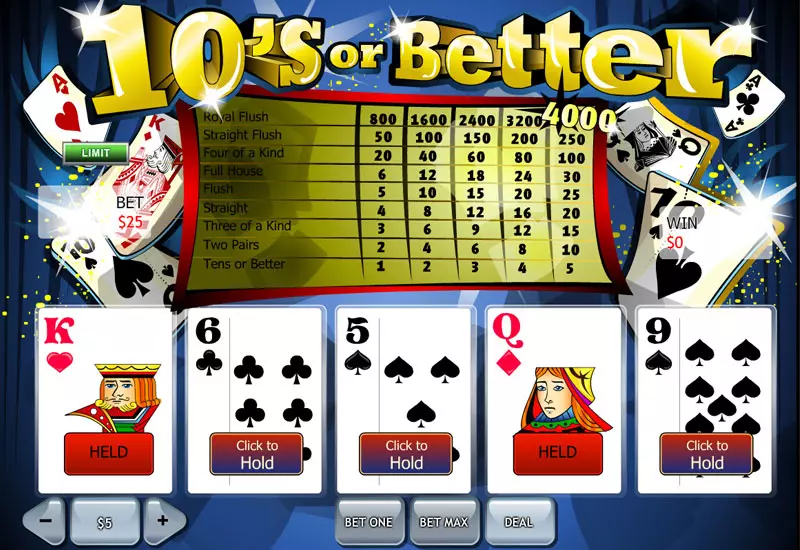Tens or Better is one of the most widely played variations of video poker and largely borrows its rules from the ever-popular Jacks or Better variant of the game. For the most part, the hand rankings of Tens or Better coincide with those of its popular cousin. However, the payouts for certain hands in the two video poker variations often differ.
The rules of the game are quite simple, so it does not matter whether players have previous experience – particularly if they have already played Jacks or Better. The game offers a relatively low house edge, especially if players incorporate a strategy into their play. The following article covers the key aspects of Tens or Better video poker, including the game’s basic rules of play, its paytable and hand rankings, as well as the optimal strategy that can improve your chances of ending your gaming session in profit.
The Basics of Tens or Better Video Poker
For the most part, the rules of Tens or Better coincide with those of Jacks or Better video poker. The game is played with a regular 52-card deck and does not utilise any jokers or wild cards. The game starts with players adjusting the size of the bet they wish to make, with the option to wager one to five credits per hand. With most variations of Tens or Better, it is possible to choose from the following denominations 0.02, 0.05, 0.10, 0.25, 0.50, and 1.00. To bet one credit, simply click on the Bet One button. Similarly, you can conveniently bet the maximum number of credits allowed in the game by hitting the Bet Max button.
Once you have adjusted the size of the wager you want to make, click on the Deal button; at this point you will be dealt your opening hand consisting of five random cards. You need to evaluate the strength of your opening hand and determine which cards it would be best to keep and which ones you should discard. To hold your preferred cards, simply click on them. Then, hit the Deal button again (depending on the software provider, the button might instead read Draw) and you will receive random replacements for your discards.
If you succeed in forming a qualifying hand that is listed in the game’s paytable, you will be paid accordingly. The lowest-ranking hand that qualifies for a payout is a pair of tens or better. If you are successful, most Tens or Better variations will offer you the option to double your profits. You will be taken to a separate game screen and will be asked to collect your winnings or double them. If you opt for the latter, five random cards will appear on the screen, but only the first, that of the virtual dealer, will be dealt face up.
Your goal is to pick one of the remaining four cards, and if it ranks higher in value than that of the dealer, your profits will be automatically doubled. However, if you fail to pick a higher-ranking card, you automatically lose the winnings you have accrued on the last hand. This is practically all there is to it when it comes to Tens or Better video poker.

The Paytable and Hand Rankings of Tens or Better Video Poker
| The Pros | The Cons |
|---|---|
| The game is simple to play. | The flush and the full house pay at shorter odds. |
| Players on a budget can enjoy it for extended periods with smaller bankrolls. | Full-pay variations are hard to come by. |
| You will pocket payouts more frequently as the lowest qualifying hand consists of paired 10s. | The likelihood of pocketing a huge payout is not as great. |
As was mentioned at the beginning, the hand rankings of Tens or Better largely coincide with those of Jacks or Better. The highest-ranking hand you can possibly form is the Royal Flush, which can award you up to 4,000 credits, provided you have bet the maximum of five credits.
This is followed by the standard poker hand ranks in descending order, namely Straight Flush, Four of a Kind, Full House, Flush, Straight, Three of a Kind and Two Pair. The weakest hand is a pair of tens or higher, which awards players even-money payouts.
Before you place your bets on a Tens or Better game, you definitely need to check its paytable, as this will indicate whether the game will provide you with sufficient value. A Tens or Better variant that offers full pay comes with a relatively low house edge of 0.70%, although it is not as low as that of Jacks or Better, which stands at 0.46%. This means that players can expect a rather satisfactory average return on Tens or Better of around 99.3% in the long run, provided they play optimally and follow a good strategy.
Video Poker Cards Generator
Expected Value and Expected Return
What Video Poker Games Pay Best
Tens or Better Video Poker
Jacks or Better
One way you can tell whether a given Tens or Better variation offers full pay is by looking at the payouts for the Full House, the Flush and the Two Pair hands. You will immediately notice that the payouts of the Full House (6 to 1) and the Flush (5 to 1) in Tens or Better are lower than those in 9/6 Jacks or Better. This might put some players off, but the truth of the matter is that Tens or Better is not that far behind in terms of profitability, since the lowest qualifying hand in the game consists of lower-ranking cards – the tens, as opposed to the jacks in the other popular video-poker variation.
The other thing you need to check in the paytable of Tens or Better is the payout for the Two Pair. A full-pay variation of the game pays winners 2 credits per credit wagered for a Two Pair. However, you may happen to find variants of Tens or Better that pay even money for a Two Pair.
This reduction is typically “compensated” for with an increase in the payout of the Full House, which in such cases pays 8 to 1. Do not be fooled by this – such variations are known as short-pay games and may cause you to lose money in the long term.
Just think about it – Two Pairs are immediate winners and occur 5% of the time, whereas the probability of forming a Full House is much lower; therefore, the one-unit increase in the payout for this hand will hardly suffice to compensate for the reduction in the payout of the Two Pair.
As a matter of fact, this further reduces the payback of such Tens or Better variations by around 6%, which is why players should certainly ignore them and invest their money in full-pay variants of the game.
| Tens or Better Video Poker Paytable | |||||
|---|---|---|---|---|---|
| Coins | 1 | 2 | 3 | 4 | 5 |
| Royal Flush | 250 | 500 | 750 | 1000 | 4000 |
| Straight Flush | 50 | 100 | 150 | 200 | 250 |
| Four of a Kind | 25 | 50 | 75 | 100 | 125 |
| Full House | 6 | 12 | 18 | 24 | 30 |
| Flush | 5 | 10 | 15 | 20 | 25 |
| Straight | 4 | 8 | 12 | 16 | 20 |
| Three of a Kind | 3 | 6 | 9 | 12 | 15 |
| Two Pair | 2 | 4 | 6 | 8 | 10 |
| Tens or Better | 1 | 2 | 3 | 4 | 5 |
Variations of Tens or Better
While you have learned which Tens or Better variant offers the best payouts, you may also come across several other variations of the game online. These options introduce slight changes to the paytable, which will affect the long-term expected return of the game. This is why it is good to recognise these options to make sure that you are playing the game that is most beneficial for you.
One of the variations you may find is 25/5/5 Tens or Better, which will offer 25 to 1 for a Four of a Kind, 5 to 1 for a Full House and 5 to 1 for a Flush. As you can see, the payout for the Full House is lowered, which brings the expected return down to 97.99%.
Another version of Tens or Better that can often be found online is the 20/6/5 one. It gives the casino quite a sizeable advantage by lowering the payout for a Four of a Kind to 20 to 1 instead of 25 to 1. Meanwhile, Full House and Flush pay the usual 6 to 1 and 5 to 1, but the expected return still declines to 97.96%.
Although it is rarely found, there is also a Tens or Better variant that has additionally lowered the payout for a Straight Flush to 40 to 1. Combined with the low payout for a Four of a Kind, this game has an expected return of 97.86%, and it is best to avoid playing it.

Tens or Better Strategy
By incorporating a good strategy into their Tens or Better gameplay, players will secure the optimal theoretical returns at the end of their betting sessions. Here, the strategy resembles that in Jacks or Better to a great extent. Since a pair of tens is the lowest qualifying hand in the game, players are usually recommended to hold the two tens after the initial deal because this way they will at least be paid even money if they fail to improve their hand.
Also, it is recommended to keep pairs of other high cards such as Jacks, Queens, Kings and Aces instead of attempting to draw to a Flush or a Straight. The only exception to this rule is when players have a Royal Flush draw. Keeping a low pair consisting of deuces through nines is not worth the effort, and such cards should be replaced in favour of Flush or Straight draws.
If players have received poor cards at the initial deal, the wisest thing to do would be to keep only tens or higher, as this might enable them to pair the card and receive an even-money payout.
Things are a bit different when one is dealt a pair of cards that are lower in rank than a ten. In some instances, it is a better idea to hold a three-card Straight or Flush instead of keeping a low pair. Also, players should at all times hold on to a four-card Royal Flush – despite the fact that only one out of five cards would be replaced, the payouts for a Royal are so large that it is well worth the risk.
There is one exception to this rule, however, when players are dealt a Straight Flush with a suited King-9. In this case, it would be smarter to keep the 9 and settle for the Straight Flush (which also pays quite impressively) instead of replacing the 9 and attempting to form a Royal.
Another recommendation is to go for more substantial payouts. Occasionally, it is better to attempt to improve your hand and aim for Royal or Straight Flushes instead of holding on to a qualifying pair or a made Straight.
Last but not least, one should always bet the maximum number of credits, which is usually five coins. The payouts on Royal Flushes for five-credit bets are indeed massive, and if you succeed in hitting the Royal but have not wagered the maximum, it would be a major let-down – after all, Royal Flushes are not something one forms every day.
If you want to use a strategy chart for Tens or Better, it should look like the following:
| Royal Flush | Hold all cards |
| Straight Flush | Hold all cards |
| Four of a Kind | Hold all cards |
| Full House | Hold all cards |
| Four to a Royal Flush | Draw one card |
| Flush | Hold all cards |
| Three of a Kind | Draw two cards |
| Straight | Hold all cards |
| Four to a Straight Flush | Draw one card |
| Two Pair | Draw one card |
| A High Pair | Draw three cards |
| Three to a Royal Flush | Draw two cards |
| Four to a Flush | Draw one card |
| One Low Pair | Draw three cards |
| Four to a Straight | Draw one card |
| Three to a Straight Flush | Draw two cards |
| Two to a Royal Flush | Draw three cards |
| Two High Cards | Draw three cards |
| One High Card | Draw four cards |
| No hand | Draw five cards |



